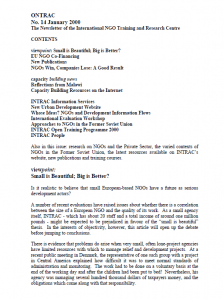 Is it realistic to believe that small European-based NGOs have a future as serious development actors? A number of recent evaluations have raised issues about whether there is a correlation between the size of a European NGO and the quality of its work. As a small agency itself, INTRAC – which has about 20 staff and a total income of around one million pounds – might be expected to be prejudiced in favour of the “small is beautiful” thesis. In the interests of objectivity, however, this article will open up the debate before jumping to conclusions.
Is it realistic to believe that small European-based NGOs have a future as serious development actors? A number of recent evaluations have raised issues about whether there is a correlation between the size of a European NGO and the quality of its work. As a small agency itself, INTRAC – which has about 20 staff and a total income of around one million pounds – might be expected to be prejudiced in favour of the “small is beautiful” thesis. In the interests of objectivity, however, this article will open up the debate before jumping to conclusions.
The European Union has recently invited a Consortium of five agencies – INTRAC, Particip (Germany), South Research, RUCA and Prospect C&S (the latter three from Belgium) – to undertake the evaluation of its co-financing operations with NGOs. The evaluation will analyse the co-financing budget line within the framework of the European Commission’s programme of development co-operation, with a view to improving the mechanisms, practices and procedures of co-financing. Overall, the evaluation will attempt to assess the performance of the budget line in terms of issues such as: the needs of poor people, the strengthening of local NGOs and civil society and the strengthening of democracy and human rights.
ONTRAC 14 also looks at a programme INTRAC established in Malawi in 1997, which aim was to strengthen local NGO Support Organisations in their ability to provide high quality capacity building services for local NGOs. This issue ends with an article on the approaches towards NGOs in the former Soviet Union, which raises the question: “Have we, as international NGOs, muddied the waters and created confusion?”.
Download:
ONTRAC 14. Small is beautiful; big is better?
.pdf (0.08mb)
Download:
ONTRAC 14. Small is beautiful; big is better? Portugese.
.pdf (0.06mb)